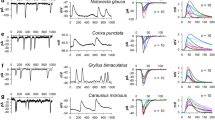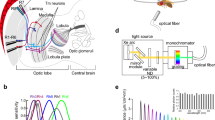Abstract
Single electrode clamp techniques demonstrated diurnal changes in photoreceptor membrane conductance, recorded intracellularly in the intact, dark-adapted retina of the locust Schistocerca gregaria. In the day, locust photoreceptors exhibited the membrane properties of fast cells, as previously defined in rapidly moving diurnal Diptera. Depolarization activated a powerful potassium conductance with two kinetic components, one rapidly activating close to resting potential and the other activating more slowly when further depolarized, giving a pronounced delayed rectification. There was little inactivation. At night, locust photoreceptors resembled slow cells, as defined in weakly flying crepuscular and nocturnal Diptera. Depolarization rapidly activated an outward current which then inactivated over 100 ms to reduce rectification. The change from day to night state was mimicked by applying 10 mM serotonin extracellularly to the retina. We conclude that the potassium conductances of locust photoreceptor membranes are modulated according to a diurnal rhythm, possibly by serotonin. This neuromodulation is used to match photoreceptor membrane properties to photic habitat. Our findings suggest a definite and potentially widespread function for serotonin as a mediator of diurnal changes in the insect visual system.
Similar content being viewed by others
References
Acosta-Urquidi J, Crow T (1993) Differential modulation of voltage-dependent currents in Hermissenda type B photoreceptors by serotonin. J Neurophysiol 70: 541–548
Arechiga H, Banuelos E, Frixione E, Picones A, Rodriguez-Sosa I (1990) Modulation of crayfish retinal sensitivity by 5-hydroxytryptamine. J Exp Biol 150: 123–143
Attwell D (1986) The Sharpey-Schafer Lecture. Ion channels and signal processing in the outer retina. Q J Exp Physiol 71: 497–536
Attwell D, Wilson M, Wu SM (1984) A quantitative analysis of interactions between photoreceptors in the salamander (Ambystoma) retina. J Physiol (Lond) 352: 703–737
Barlow RB, Chamberlain SC, Kaplan E (1977) Efferent inputs and serotonin enhance the sensitivity of the Limulus lateral eye. Biol Bull 153: 414
Barlow RB, Chamberlain SC, Lehman HK (1989) Circadian rhythms in the invertebrate retina. In: Stavenga DG, Hardie RC (eds) Facets of vision. Springer Berlin Heidelberg New York London Paris Tokyo, pp 257–280
Barnes S (1994) After transduction: response shaping and control of transmission by ion channels of the photoreceptor inner segment. Neuroscience 58: 457–459
Blest AD (1988) The turnover of phototransductive membrane in compound eyes and ocelli. Adv Insect Physiol 20: 1–53
Bobker DH, Williams JT (1990) Ion conductance affected by 5-HT receptor subtypes in mammalian neurons. Trends Neurosci 13: 169–173
Coles JA, Schneider-Picard G (1989) Amplification of small signals by voltage-gated sodium channels in drone photoreceptors. J Comp Physiol A 165: 109–118
Crow T, Bridges MS (1985) Serotonin modulates photoresponses in Hermissenda type B photoreceptors. Neurosci Lett 60: 83–88
Emptage NJ, Marons EA, Stark LL, Carew TJ (1994) Differential modulatory action of serotonin in Aplysia sensory neurons: implications for development and learning. Seminars in Neurosci 6: 21–33
Eskin A, Maresh RD (1982) Serotonin or electrical nerve stimulation increases the photosensitivity of the Aplysia eye. Comp Biochem Physiol 73C: 27–31
Fain A, Lisman JE (1981) Membrane conductances of photoreceptors. Prog Biophys Molec Biol 37: 91–147
Hardie RC, Voss D, Pongs O, Laughlin SB (1991) Novel potassium channels coded for by the Shaker locus in Drosophila photoreceptors. Neuron 6: 477–486
Hateren JH van (1992) Theoretical predictions of spatiotemporal receptive fields of fly LMCs and experimental validation. J Comp Physiol A 171: 157–170
Hevers W, Hardie RC (1993) Serotonin modulated Shaker potassium channels in Drosophila photoreceptors. In: Elsner N, Heisenberg M (eds) Gene-Brain-Behaviour. Georg Theme, Stuttgart New York, p 631
Hevers W, Hardie RC (1994) Serotonin modultes the voltage dependence of Shaker potassium channels in Drosophila photoreceptors. Neuron (in press)
Homberg U (1994) Distribution of neurotransmitters in the insect brain. Prog Zool 40: 1–87
Howard J, Dubs A, Payne R (1984) The dynamics of phototransduction in insects: a comparative study. J Comp Physiol A 154: 707–718
Isom LL, De Jongh KS, Catterall WA (1994) Auxiliary subunits of voltage-gated ion channels. Neuron 12: 1183–1194
Laughlin SB, Weckström M (1993) Fast and slow photoreceptors-a comparative study of the functional diversity of coding and conductances in the Diptera. J Comp Physiol A 172: 593–609
Nässel DR (1987) Serotonin and serotonin containing neurones in the nervous systems of insects. Prog Neurobiol 30: 1–85
Nässel DR, Klemm N (1983) Serotonin-like immunoreactivity in the optic lobes of three insect species. Cell Tissue Res 232: 129–140
Perozo E, Vandenburg CA, Jong DS, Bezanilla F (1991) Single channel studies of the phosphorylation of K+ channels in the squid gaint axon. J Gen Physiol 98: 1–17
Snyder AW (1979) Physics of vision in compound eyes. In: Autrum H (ed) Handbook of sensory physiology vol VII/6A Springer, Berlin Heidelberg New York, pp 225–313
Tomioka K, Ikeda M, Nagao T, Tamotsu S (1993) Involvement of serotonin in the circadian rhythlm of an insect visual system, Naturwissens chaften 80: 137–139
Vallet AM, Coles JA (1993) Is the membrane voltage amplifier of drone photoreceptors useful at physiological light intensities? J Comp Physiol A 173: 163–168
Vallet AM, Coles JA, Eilbeck JC, Scott AC (1992) Membrane conductances involved in amplification of small signals by sodium channels in photoreceptors of drone honey bee. J Physiol (Lond) 456: 303–324
Weckström M (1994) Voltage-activated outward currents in adult and nymphal locust photoreceptors. J Comp Physiol A 174: 795–801
Weckström M, Hardie RC, Laughlin SB (1991) Voltage-activated potassium channels in blowfly photoreceptors and their role in light adaptation. J Physiol (Lond) 440: 635–657
Weckström M, Juusola M, Laughlin SB (1992) Presynaptic enhancement of signal transients in the photoreceptor terminals in the compound eye. Proc R Soc Lond B 250: 83–89
Williams DS (1982) Photoreceptor membrane shedding and assembly can be initiated locally within an insect retina. Science 218: 898–900
Williams DS (1983) Changes of photoreceptor performance associated with the daily turnover of photoreceptor membrane in locust. J Comp Physiol 150: 509–519
Wilson M (1975) Angular sensitivity of light and dark adapted locust retinula cells. J Comp Physiol 97: 323–328
Author information
Authors and Affiliations
Rights and permissions
About this article
Cite this article
Cuttle, M.F., Hevers, W., Laughlin, S.B. et al. Diurnal modulation of photoreceptor potassium conductance in the locust. J Comp Physiol A 176, 307–316 (1995). https://doi.org/10.1007/BF00219056
Accepted:
Issue Date:
DOI: https://doi.org/10.1007/BF00219056




